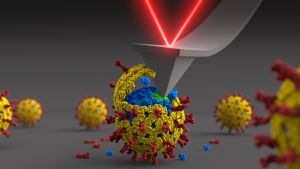Viruses are small agents that enter and hijack cells to create more of themselves. Most of them are made of a protein shell that encases the viral genome and certain molecular tools. During the life cycle of a virus, this shell fulfils many roles, from protecting the genetic information to recognising the appropriate host cell. It must also disassemble at the right time for replication to take place.
A number of viruses wrap themselves in several layers of protective casing, resulting in an onion-like structure. For example, the rotaviruses that sometimes cause severe diarrhoea in young children have three layers, each with specific properties. Rotavirus subparticles may exist with only one or two of these coats, which allows researchers to study each layer in detail.
Here, Jiménez-Zaragoza et al. use a method called atomic force microscopy to look into the physical properties of the layers of the rotavirus. The technique uses an extremely sharp stylus attached to a tiny cantilever to deform the shells of a single virus. How the structure reacts can then be recorded using a powerful microscope. This helps to determine the stiffness of the layers, and how much force is required to break or weaken each of them.
The experiments reveal that the mechanical properties of the layers are tailored to help the virus survive and infect cells. The outer coat is stiff and resistant to strain, which shields the virus during its travel through the digestive system. The middle layer is the thickest and the softest of the three. It allows the virus to cope with deformation, which is necessary for the expression of its genome.
The outer and middle layers are strongly connected, in part through calcium ions that may be ‘sandwiched’ between the two. By contrast, the middle and inner layers are only loosely attached to each other. When the virus enters the cell, the calcium ions get dislodged, helping the external coating to easily disassemble. In turn, this creates structural changes in the middle layer, which activate molecules required for the genome to get expressed. Ultimately, disrupting the finely tuned properties of the layers could create new ways of fighting rotaviruses.
- Manuel Jiménez-Zaragoza, Marina PL Yubero, Esther Martín-Forero, Jose R Castón, David Reguera, Daniel Luque, Pedro J de Pablo, Javier M Rodríguez. Biophysical properties of single rotavirus particles account for the functions of protein shells in a multilayered virus. eLife 2018;7:e37295.






